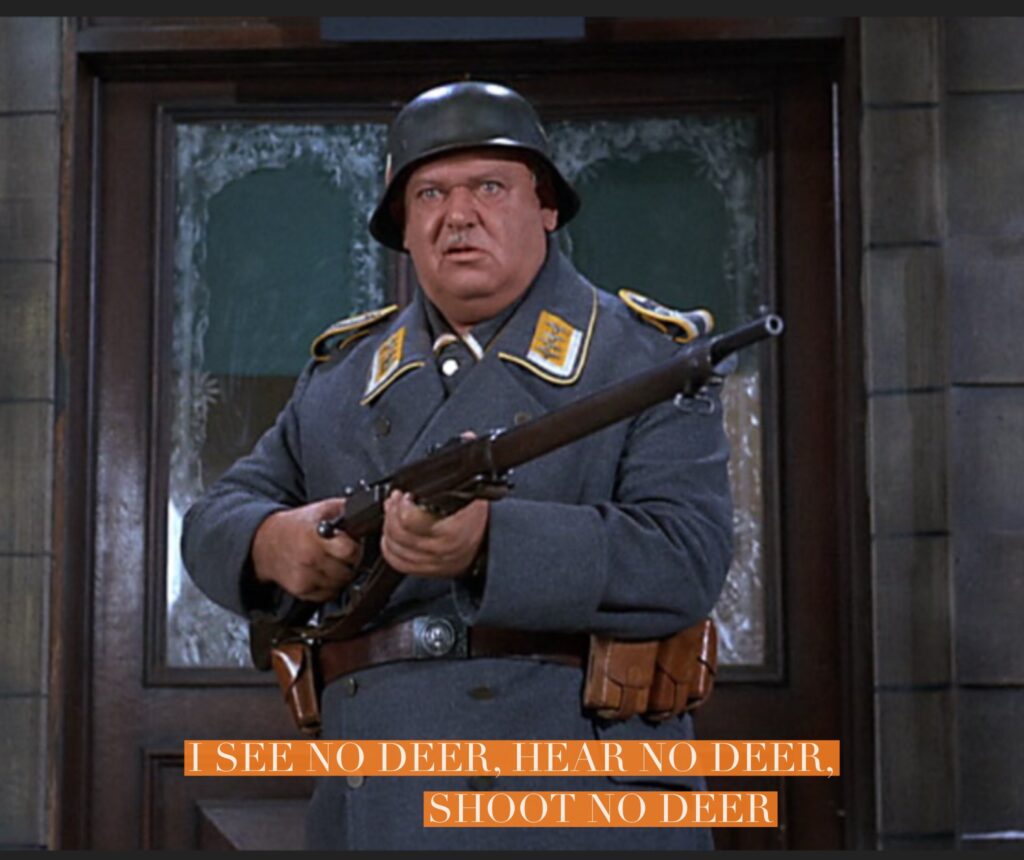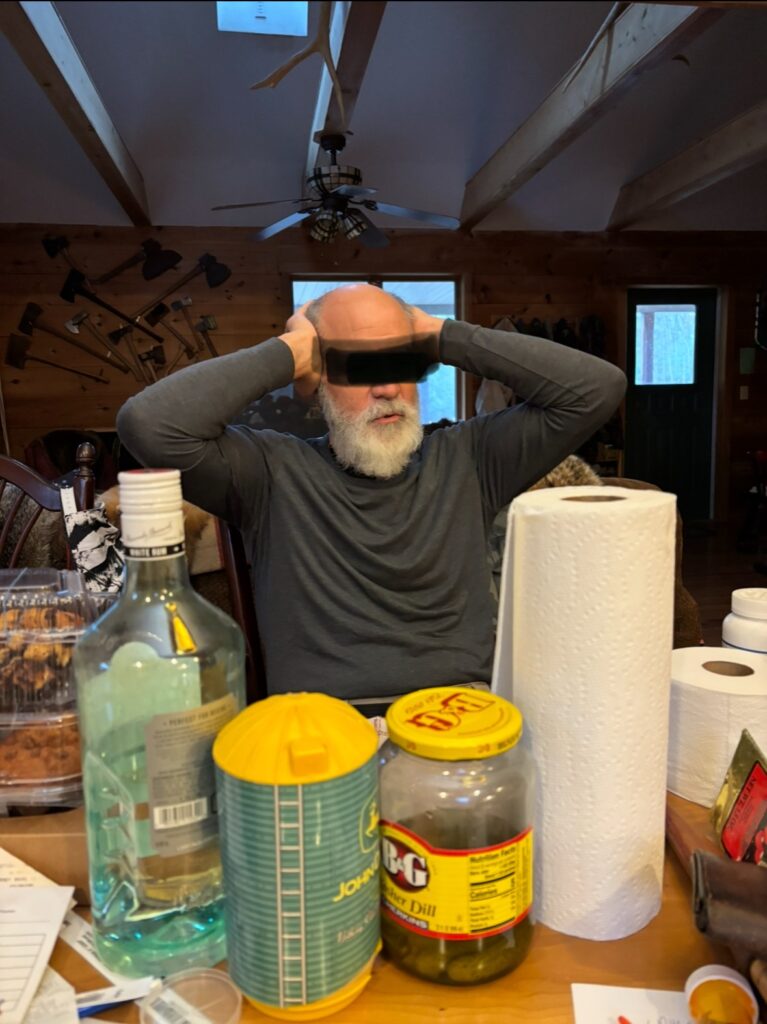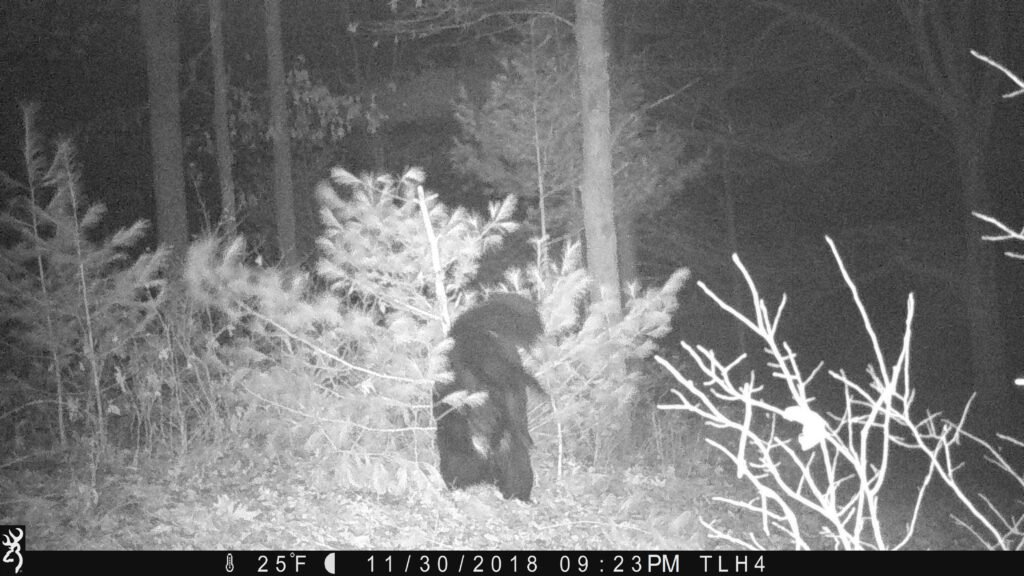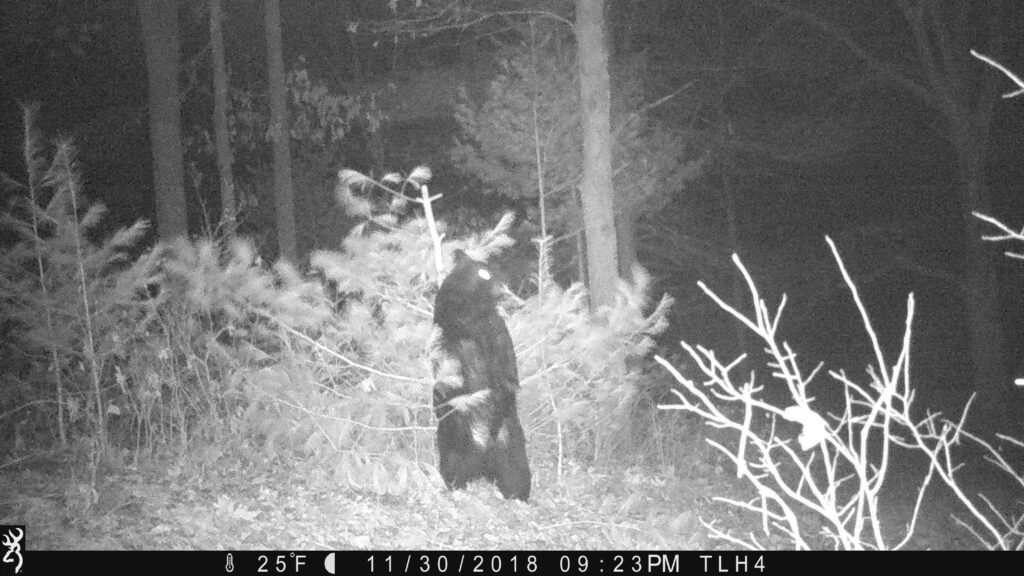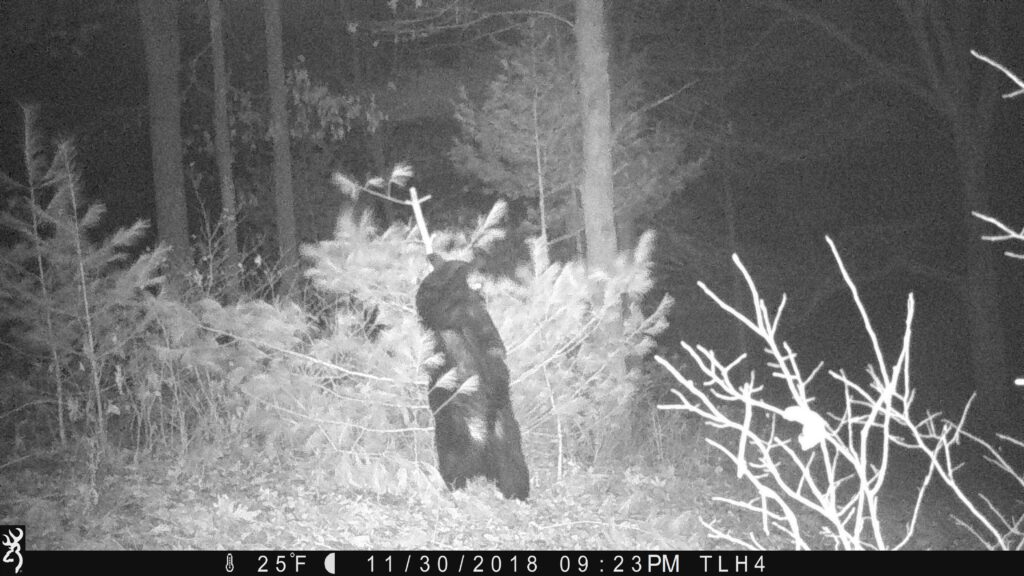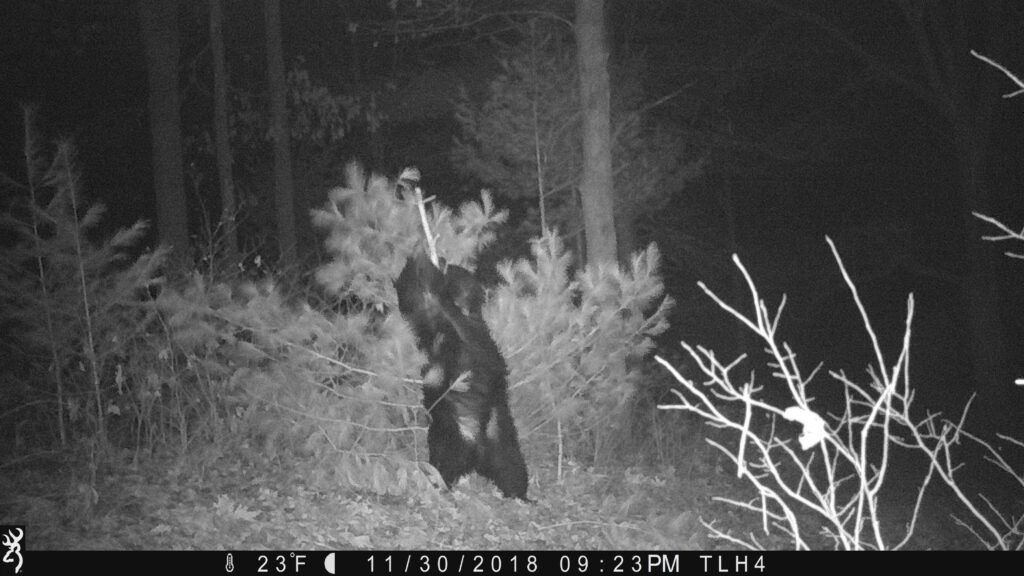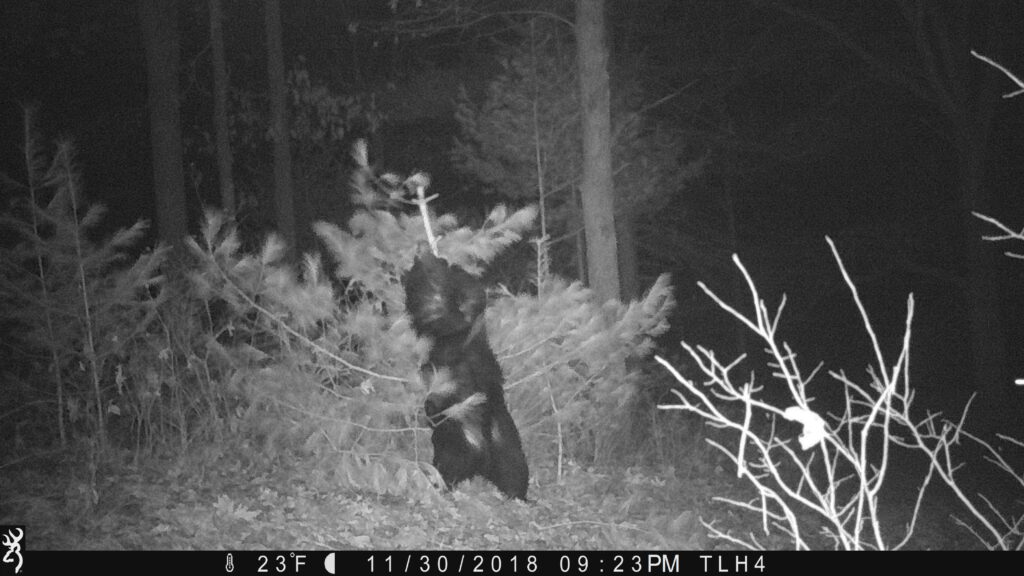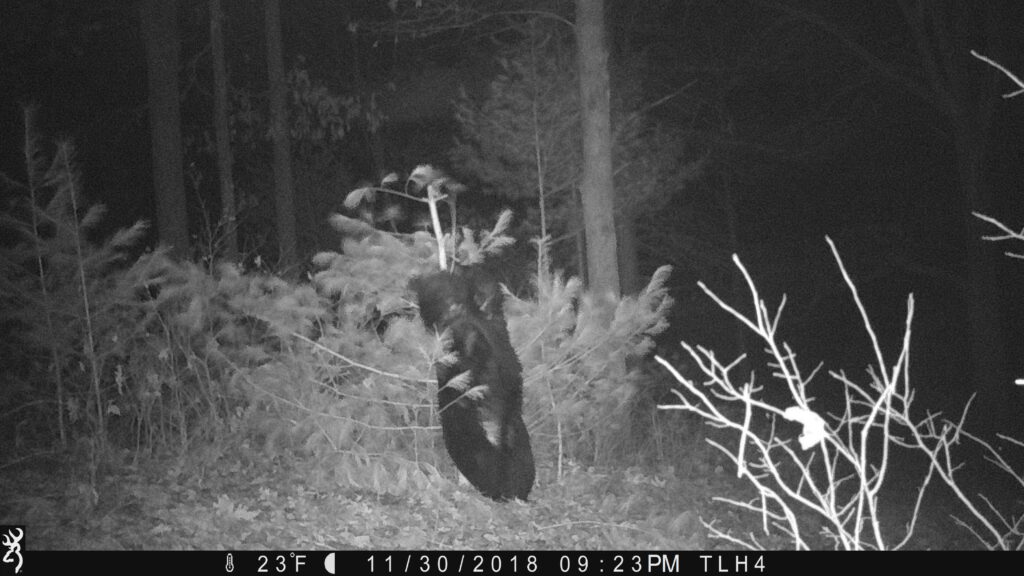Posts Tagged → drive
Pennsylvania seasons…the one that really matters
The longstanding quip that Pennsylvania has two seasons, road construction season and hunting season, still stands.
Anyone living in PA can attest to the seemingly endless roadwork everywhere here that begins in May and ends in November. At one time, Pennsylvania had the greatest miles of roads to square miles of area of any state; but, according to a random 2018 chart on the Internet, eight years ago PA ranked #7 and was pretty much tied with Indiana, Maryland, and Delaware in this regard.
New Jersey now holds this dubious record of most linear road miles to square miles of area, which surprises no one, given how urbanized NJ is. But it seems that no state makes so many crappy roads and bridges quite like PA, and so we do have the endless road construction to fix them, and thus, the adorable quip.
It does seem that our highways and bridges are always failing, or about to fail. Whether this is because of bad contracting, corrupt payoffs like with the recent PA Turnpike scandal, or the high number of freeze-thaw cycles our roads go through, it is tough to know. But whateva… the quip strikes home, every time.
Our other season is worth about $1.5 Billion annually. Call it Elmer Fudd Season, Deer Season, or Red-Check-Plaid Pennsylvania Tuxedo Season, hunting season is still a huge part of Pennsylvania’s culture and economy. Thank God above. This is the Pennsylvania season that really matters, though it has been changing in the past twenty years and ten years, respectively, as more doe permits have been issued and as bear and deer season openers have moved from Mondays to Saturdays.
Despite all the seasonal scheduling changes, which have resulted in northern hunting camps losing their traditional gatherings for big bear and deer drives, the easily renewable economy of hunting chugs along. No broken bridges or defunct roads here; the money just happily flows and flows and flows.
Outdoors people, of which Pennsylvania has a lot, really like to have nice outdoors lifestyle stuff. Things like camouflage flatware, camouflage lingerie, camouflage radios (conveniently made to look exactly like forest floor leaf litter, so that when you inevitably drop your radio, it becomes invisible and forever at one with said forest floor, and you have to go buy a new one), camouflage tee shirts, ammunition, guns (no one ever has enough guns), boots (no one ever has enough hunting boots), fishing rods, fishing lures and hooks, ATVs, etc.
And so here we are, four days into the 2025 PA deer rifle season, and EVERYTHING SUCKS. As in, I have heard nothing but nonstop bitching from friends, acquaintances, and even people I do not know who I bump into at the gas pump, about the lack of deer. And for once, I have to agree with these grouchy complainers. Count me in as one of you guys this year.
Normally, I would scoff and deride these complainers as bad hunters, or unappreciative hunters, but the truth is, I am also having a Bad Hunter kind of rifle season myself. And this is on top of last week’s bear season, where my wonderful flatlander friends, whom I love and whose company I enjoy very much, continued to yet again miss gimme shots on huge trophy bears on tough bear drives, just so they can promise to come back and “git ’em next year.”
Trying to not disappoint me, they say.
Whether there is some kind of invisible solar flare activity that we humans are not privy to, but which is very important to the life of deer, or an alien space ship picked up and removed all the deer in PA, our deer hunting season is off to a weird start. Everywhere, as far as I can discern. It is certainly true without any doubt that most of the deer are having teenage human type life cycle inversion, where 2:00 AM is the time of most activity, and 2:00 PM is for sleeping. Exactly where all the deer are sleeping is a great mystery that a lot of us have sweated off a lot of calories trying to determine the past 72 hours.
Trail cameras report back legal bucks and bands of does traveling past places we normally guard with a rifle, but in the middle of the night, when we are sleeping off that 1,500 foot elevation climb to the mountain top that has zero acorns and zero deer sign. And then there is the descent at dark, the harder part.
So I am going to nominate a third season of sorts, maybe temporary, maybe only for the beginning of the 2025 deer rifle season here in PA: Bitching, Moaning, and Grumbling Season.
Right now and for the next ten days, it is the only season that matters. Good luck, fellow deer hunters!
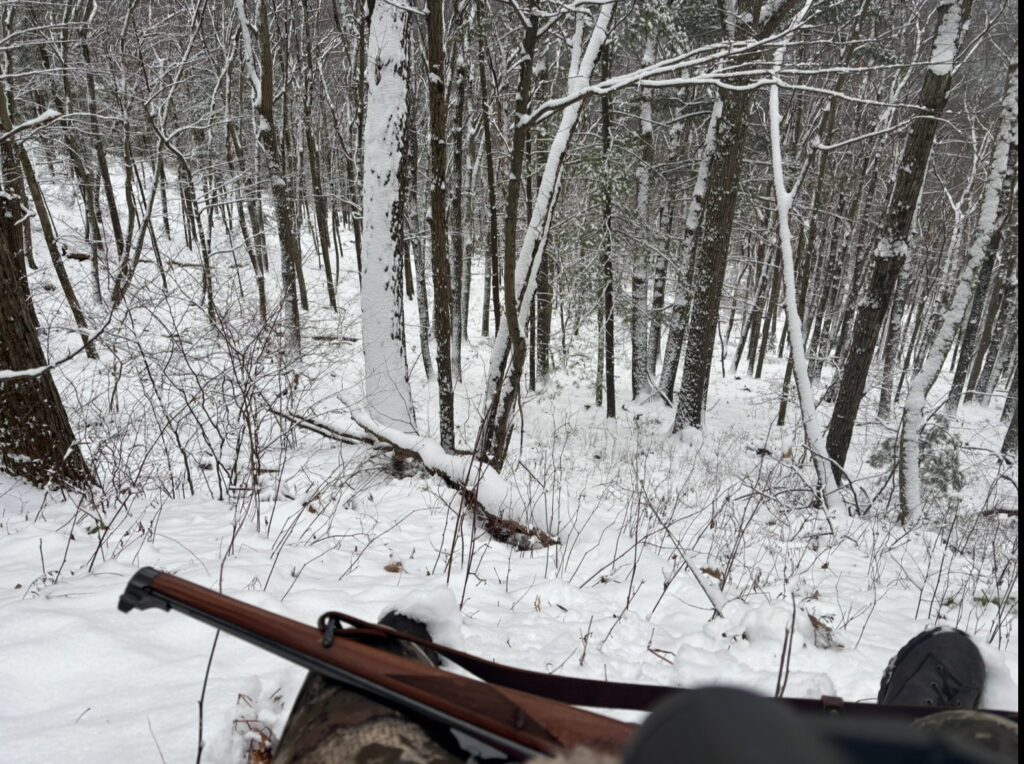
How many Central PA deer hunters spend our time for two weeks, overlooking a deep wash or draw and picking out shooting lanes. Snow makes it perfect, But we still need deer to show up…
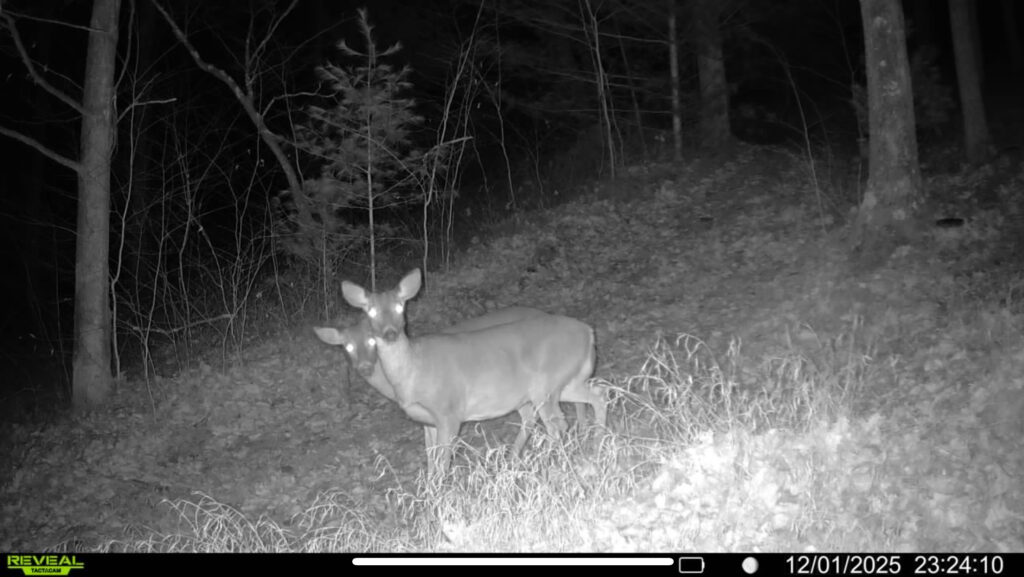
Who us? Yes, it is 11:24 PM in a location with little hunting pressure or human activity, and the deer have gone totally nocturnal.
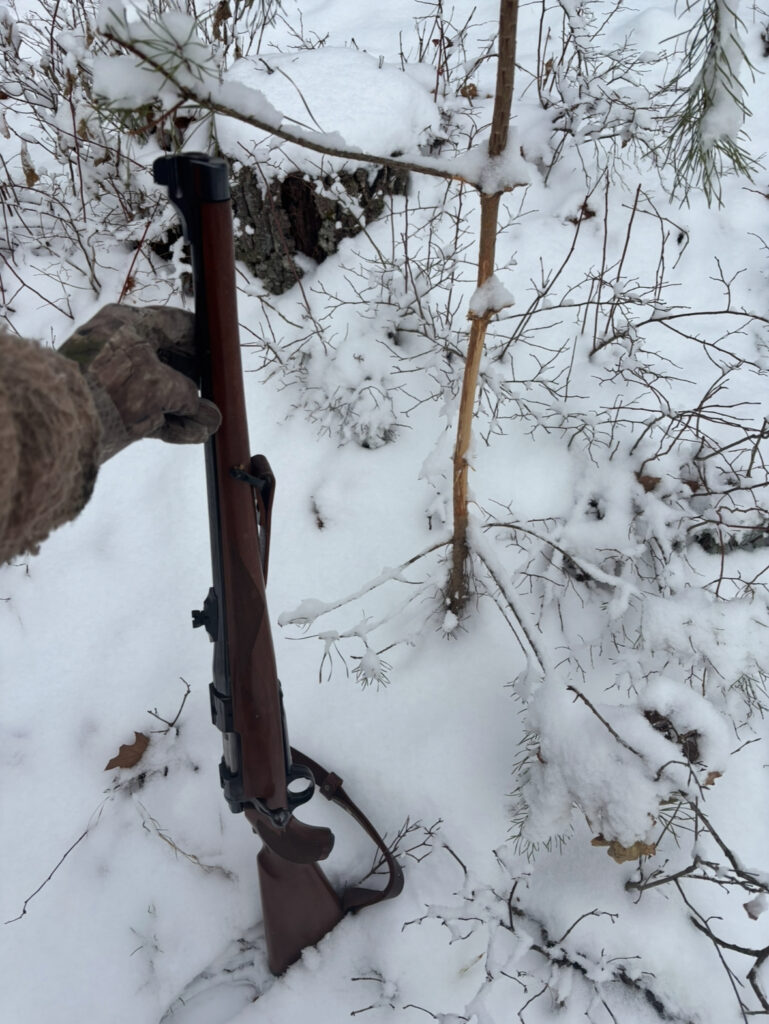
Maybe not an impressive rub, but the scrawny six point caught on camera that we derided two weeks ago would be most welcome right about now, as the monster 150 inch twelve point has not been seen for two weeks…
Much, much to be thankful for in America
Tomorrow is Thanksgiving, and there is so much to be thankful for here in America. Let’s start with the “small” things, which we take for granted:
-Surfeit of food, of all tastes, colors, varieties, amounts. At bear hunting camp this week (pictures below), people brought a wide variety and overwhelming amount of snack food, in addition to the high quality main course ingredients. Super rich, high-calorie, high fat, mostly sugar and corn syrup as the first or second ingredient, this “snack” stuff could feed an African village for a week. But it is practically poison here in America. We take it for granted, and often reach for it out of boredom, never out of need. It is killing our health, with way too many Americans obese and diabetic. The good stuff, like amazingly abundant and cheap fresh fruit and vegetables, does not blast our palates with artificial flavor, and is shunted aside.
-Paved roads, which are not common in much of the world. Americans like our paved highways and by-ways, everywhere. They are enjoyable to drive on, and are so smooth that we can eke every possible bit of gas mileage efficiency out of our personal vehicles as we shave minutes off of long distance trips. Importantly, our highways are made from quarried rock and oil pumped out of the ground.
-Personal vehicles are not a get-to-work or manage-the-farm necessity for half of America, but are rather the higher-end personal statement of appearance and perception, of how we want others to see us. Meanwhile, half the world still uses horses, donkeys, and cattle to transport food and goods. The next time our personal car gets a scratch, let’s remember that a vehicle is but a tool, and tools get used and scratched. Let’s not take these super expensive tools for granted.
-Shelter, like a home, has rapidly changed in concept in just a few decades. Our grandparents aspired to own a home of about 900 square feet in size. And while we mocked 1980s tyrant Imelda Marcos for her huge closets and psycho big shoe collections, a lot of car garages are now about 900 square feet, while the homes they are attached to are 3,500 square feet. Meanwhile, our own families have shrunk in size since the 1950s, compared to our grandparents’, but our homes are generally exploding in opulent size and personal service.
While I do not question or judge market forces like supply and demand, we must be thankful for what we have available to us, dammit. The tin shanty favelas surrounding Mexico City were filled with domesticated animals and pobrecitos human beings, all under one small leaky roof made of rusty corrugated metal; the things I saw then still haunt me even now.
I am not trying to be a scold or a downer, but man oh gees, do we as a nation need to be super duper thankful to each other and to the One Above for all the blessings this incredible America enjoys. If we take these myriad blessings for granted, then we will take anything and everything for granted, including each other. And when people take each other for granted, their relationships fail. American citizens need to have a close relationship with each other and with our self-representative government. It all goes together, hand in glove.
Tomorrow, we must all give deep thanks for what we have, and show appreciation for it all. Not the least of which is living in the wealthiest, freest nation ever created by humans.
Happy Thanksgiving, my fellow American citizens!
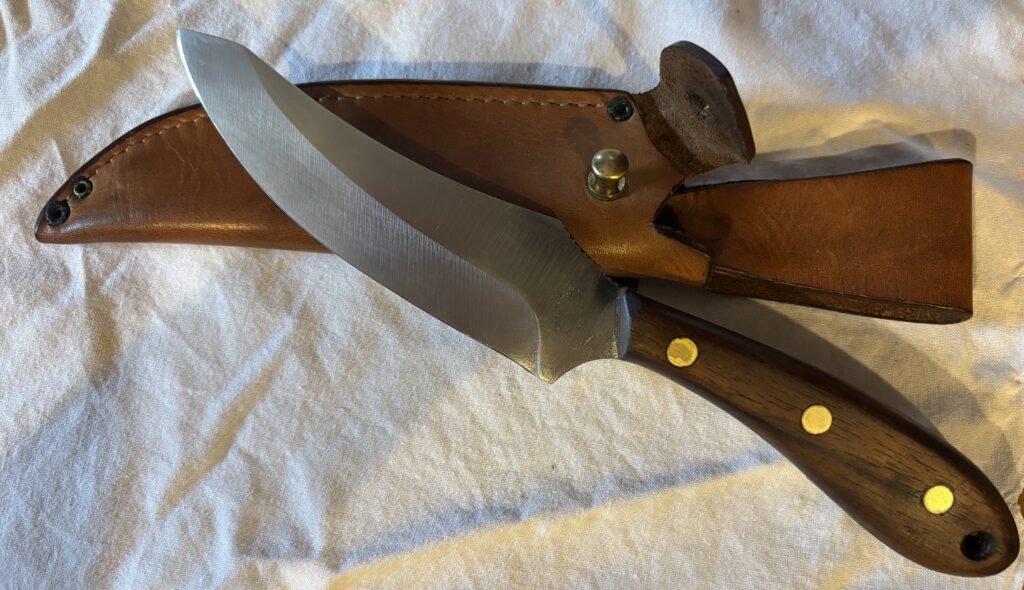
A 1970s Grohmann “skinner” knife gifted to me by a friend whose dad hunted with me. It was dull as dishwater until Irv worked his magic on it. It now shaves hair and has a heavy dose of home-made cutting board butter on the rosewood handle. It goes deer hunting this weekend.
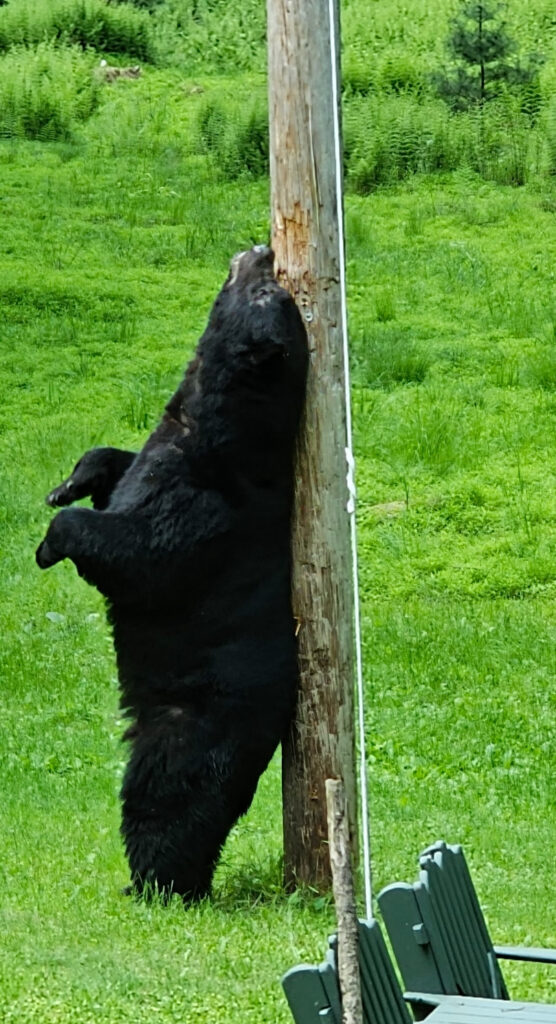
The bear we caught up in our Monday drive, seen here back in July. Estimated at well over 7′ and 600-700 pounds, he escaped with but a scratch from an excited hunter who did not take his time and aim carefully. Photo by Bob G., thank you.
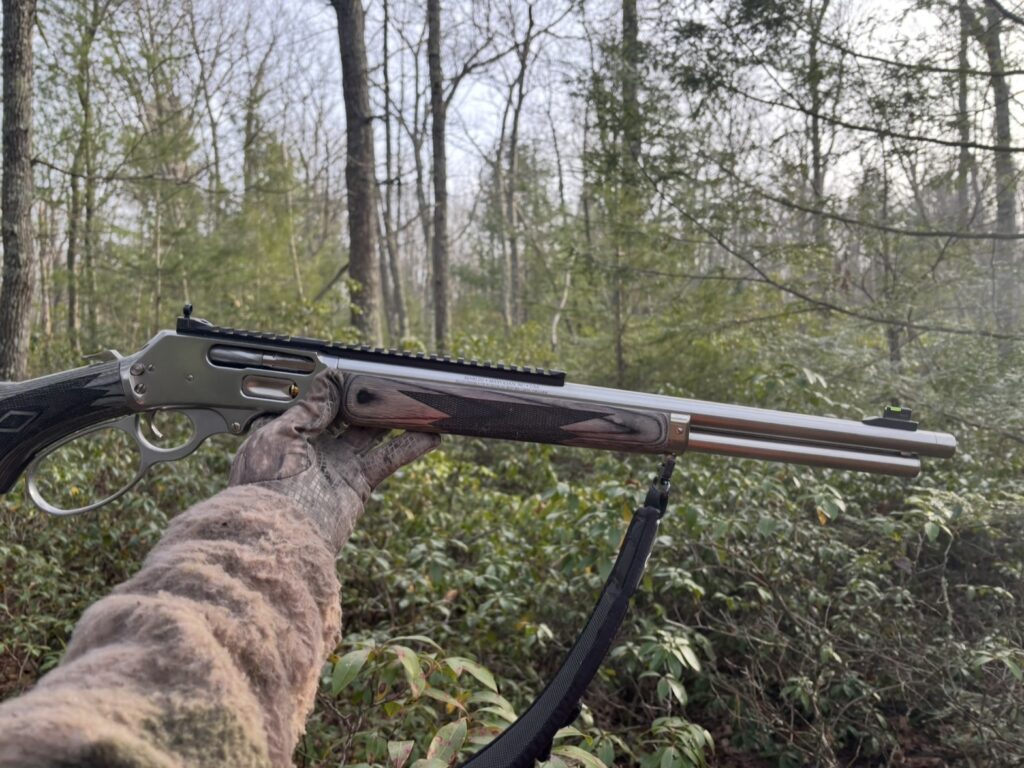
The Ruger Marlin 1895 45-70 in the mountaintop laurel jungle minutes before our drive made contact with the big bear.
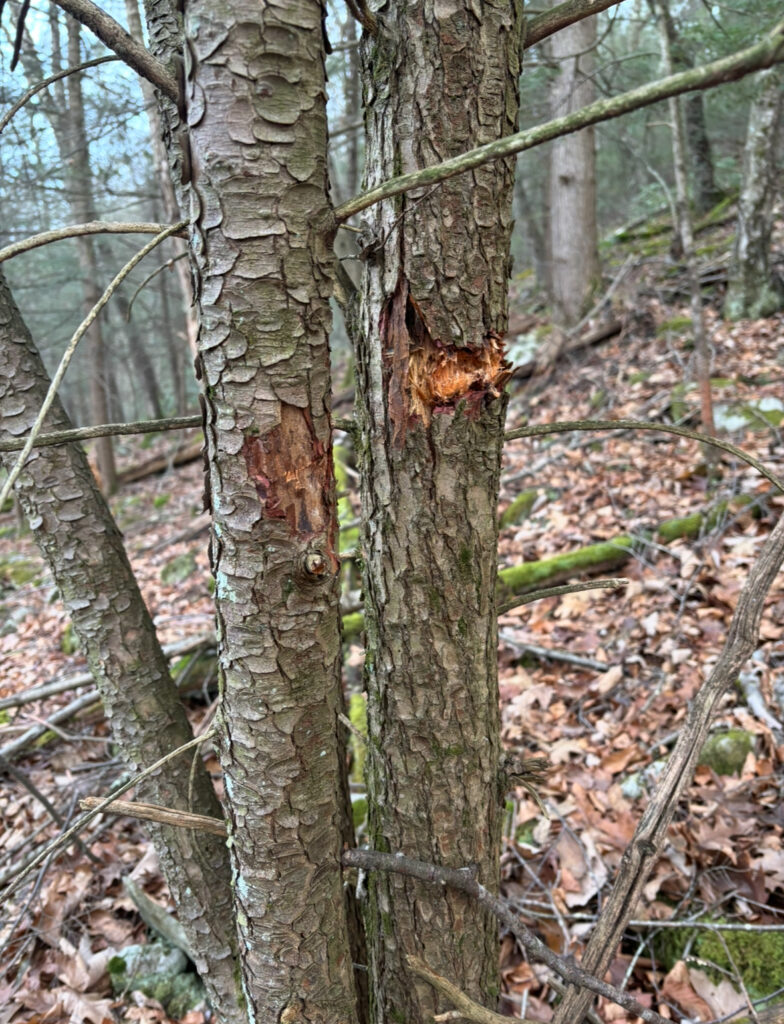
When shot wild and excitedly, twelve gauge copper slugs will kill only trees, and not the bear-of-five-lifetimes
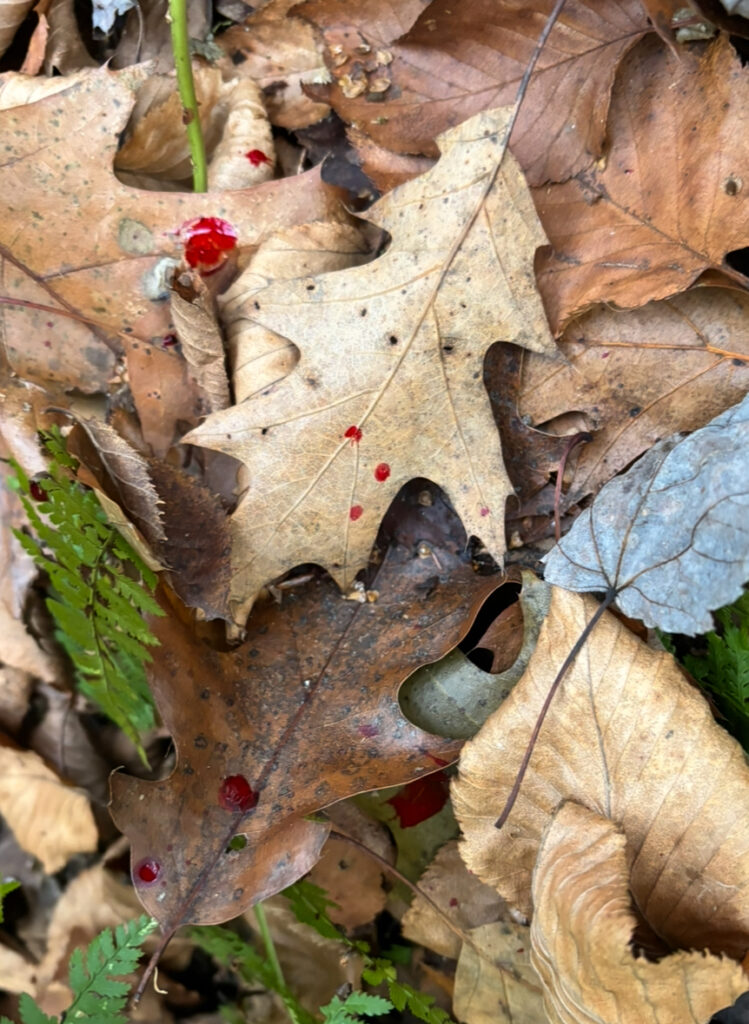
Light blood trail went for 1500 feet, and then disappeared. We determined his left front leg had been nicked, not hard. Lucky bear, sad hunter
Is sitting in a box actually hunting?
Hunting season is cold, and getting outside to seek deer or bear or really any other wild game animal requires a person to put up with some level of discomfort. You can put a lot of effort into hunting, and still come up empty handed. So to up the odds of escaping the attention of deer and bear, some hunters created hunting blinds up in trees. The least difficult ones were railroad sikes driven into a tree to be used as a ladder, and we would hoist ourselves up onto a stout lower limb, and there wait for a shot at a passing deer.
The truly old tree blinds from the 1930s and 1940s were ridiculously frail, made of random assortments of surplus lumber; practically death traps as soon as they were nailed up to living trees. The better old fashioned tree stands would usually be put on what we called an “Indian tree,” where someone a long time ago had deliberately bent over and caused a tree to grow parallel with the ground.
When the horizontal bent limb was at least a foot in diameter, enterprising hunters would find creative ways to attach a stable platform, usually reached by a dangerous rickety wooden ladder made out of woods trash and nails. Platforms ranged from plywood to rough cut boards, some with railings and tattered old olive drab canvas and maybe a stool. Deluxe versions had some sort of roof or covering to keep rain, snow, and sunshine off of the hunter. These elevated hunting blinds were usually eight to ten feet up off the ground, and if the rickety blind did not fall down and kill you, the hunter, then you could usually use it to kill a deer. Despite requiring skill just to stay in them, these blinds were always in demand, and elders got first dibs.
Here I am talking about the American Northeast, and Pennsylvania, specifically. Not about India, where the elevated machan gave hunters of dangerous game not only an opportunity to shoot before being detected by tigers and leopards, but a chance to get in at least one more shot or even a stabbing blow with a spear before the claws and fangs were at your throat.
Fast forward fifty years, and now elevated blinds are everywhere. But they are not like the old rickety kinds jimmied onto trees with long spikes us older guys fondly recall. Witness the rise of the elevated box blinds, which are light years ahead of the rickety wooden tree stands in use when I was a kid. These new ones look like Martian landers, and are sold along the side of RT. 15 from Duncannon to Williamsport, as well as anywhere farm machinery and grains are sold, or even in Amish farm yards.
These modern elevated hunting blinds are airtight, have windows that open and close, and safe ladders or steps made of treated lumber of metal. They are downright sophisticated, and one farm lease I know of has propane heaters in all of their elevated “huts” where guys literally cook their breakfast while waiting for a deer to show up out one of the sliding windows. Some of them are big enough to hold a whole family, and indeed these are like little remote hunting cabin outposts, where everyone from Pap to the youngest kids can comfortably take a poke at a deer from a steady rest with plenty of quiet encouragement around them.
The question is, Is this elevated box blind business actually hunting?
My four-plus-inch-thick 1987 Random House Dictionary (the resilient if lonely, unknown cornerstone of our written culture) says Hunt: To chase or search for game or other wild animals for the purpose of catching or killing.
How much chasing or searching do you see going on from the ubiquitous elevated box blinds?
Not a lot. Well, none. Shouldn’t hunting involve actual pursuit and physical exertion? Don’t we need to earn our kills?
Go on YouTube or Rumble, and you can watch hundreds of “hunting” videos of hunters sitting in elevated box blinds, overlooking crop fields and power lines. These hunters usually have a long period of self-discussion to their camera about what they are looking for, any shots taken and misses they have had, etc. They have tripods and bipods, heaters, shelves with food, windows, and are generally protected from the punishing elements that mark hunting season.
The most dispiriting of this video genre has little kids holding forth, as if experienced adults, about the relative merits of various bucks caught on cell camera trail cams that very morning, and whether or not any of them are good enough for our young camerman.
And so I think we have to ask if this elevated box blind is not really hunting, then is it good for hunting? If maintained as a hunting method after their first one or two confidence building kills, the little kids are for sure being ruined by this stuff. Because it is not reality.
People who think that hunting season solely involves sitting in one spot all day, especially an enclosed and elevated spot, and then stiffly climbing down to either bitch about the lack of deer or worse, to boast about one’s prowess whacking “the big one“, are not hunters. They are shooters. If they have at all practiced target shooting before season, and they have some huge Hubble Telescope mounted on their Million Magnum Blastem Rifle, then surely they can make that three hundred yard shot on some unsuspecting deer eating dinner in a crop field.
Sorry to be negative about this, but we are losing our souls to these elevated blinds. Yes, they make hunting season more comfortable, and they make ambushing and surprising our quarry easier, but they are really dumbing down and whittling off our hunting instincts and skills, our woodcraft that separates us from the flatlander slobs who have no self reliance abilities. Hunting is not supposed to be easy, or comfortable, it is supposed to test us and make us earn the trophies we kill.
In Europe and Asia, hunting was used until the 1800s by warriors to hone their combat skills. Nothing like dismounting your horse to face off at ground level with a mean 4,000 pound Gaur or a ferocious 1,000 pound wild boar, armed with a stout spear in hand and a short sword at your hip. Back then, hunters were tough. As were our own American Longhunters on our frontier.
You want to actually hunt? Go do a deer drive like the BNB Outdoors kids, or with The Hunting Public guys. Or take a quiet, slow still hunt woods walk like John does at Leatherwood Outdoors. These hunts take skill and effort, which is the heart and soul of the chase. Everything else is just a hands-on video game at this point. No thanks.

A deer taken while still hunting two weeks ago, with open sights. Don’t look too closely, it was hit between the eyes.
Why do people trespass on private property?
During one of his many temporary incarcerations, infamous bank robber John Dillinger was asked by a news reporter why he robbed banks, and he famously quipped “Because that’s where the money is.” Funny enough, true enough, but Dillinger eventually ended up being shot to death by both civilians and a ragtag assortment of law enforcement agents who were fed up with his lawlessness.
I have been similarly wondering: Do people, particularly hunters, trespass on private property because that is where the wild game is? Or is there some other reason that turns otherwise normal people into lawless jerks who instigate their victims into acts of violent retaliatory fury?
My observation and experience is hunters, in particular, trespass on posted private land, and end up poaching wildlife there, because they are drawn to the mystery and promise of new territory. They think that a plot of private land that is carefully cultivated wildlife habitat must have some really nice, abundant, maybe even trophy wildlife on it. And sometimes these outlaws do, in fact, stumble into a kind of bank vault of wildlife, where they feel like they have hit the jackpot.
The problem with trespassing on posted private hunting land is that someone else, the landowner or a club that leases from the owner, has probably spent a lot of time and resources maintaining that land. Paying the real estate taxes on it, managing it, making it a sanctuary or haven for wildlife. All year long that landowner runs chainsaws, plants and prunes fruit trees, sprays herbicides, clears trails, plants various crops like clover that most wildlife find attractive.
These considerable efforts are done for the benefit of the landowner, his family, his friends, or for the club members who pay him for the opportunity to exclusively hunt there, in a very brief window of time. Hunting seasons are usually just a few weeks long. This investment of time and money is like any other investment, say, a savings account at your local bank. Or your retirement pension.
Trespassing and poaching are not victimless crimes. A landowner’s entire year’s work can go out the window from it.
Trespassers enter into the private property and, purposefully or by mistake, disturb the wildlife, maybe scare it away and off the property; poachers kill the wildlife. These disruptions come at a great cost to the landowner, who for 50 prior weeks has been working hard, husbanding the land’s natural resources, and suddenly finds himself at a disadvantage when he should be reaping his just reward.
Someone else has come along and taken advantage of all his hard work and investment, someone else has claimed his reward that he was looking forward to. Most often, the trespass intrusion and poaching so greatly disturb the property’s carefully arranged balance, that the landowner gets little to nothing of what he had worked so hard to attain. And hunting seasons are so brief that there is no time to wait out the disturbance.
This is exactly how both trespassing and poaching are forms of theft. Thievery. Scumbag-ness. Dirtball-ness. A-hole-ness. And when someone has stolen something from the landowner, the landowner can get angry about it. Sometimes really, really angry. Especially if the thief acts like the whole thing is no big deal. Because it is a really big deal to screw a landowner over and steal away from him his hard work and promise of success.
Confession time: I have been a scary person when encountering trespassers and poachers (scary to them and often to me). Not long ago a warden asked me to consider becoming a deputy warden, and I responded that I could not do that, because I get so angry at trespassers and game thieves that it would be unbecoming to see someone in an official uniform lose their cool. Yes, I have had people charged in court, but often my hand tightly around someone’s shirt collar while they get roughly dragged off the property is enough to convince trespassers that other venues hold more promise and less danger. I don’t know if many other landowners operate this way, but I am super old school. A facility with firearms and knowledge of the law also helps build confidence when dealing with armed trespassers and poachers.
As one state trooper said to a trespasser I had roughly collared, “Yes, Josh is armed. But YOU are armed, too. Is he supposed to let you shoot him so you can make your getaway? Here is your citation, do not come back here.”
Some people trespass because they are looking for things to steal, including rare plants or animals, or to drive off wild game they don’t want the landowner to get. Others trespass so they can poach wildlife through illegal hunting. Others may simply get a jolt of excitment, or are simply curious.
Folks, trespassing and poaching are a really big deal. Some landowners make a significant income from leasing their hunting land, and poachers undermine that investment. Some landowners treasure their privacy, and seeing an armed thief skulking around their property makes them feel directly threatened. So don’t do it. Don’t think it is no big deal to slip past the No Trespassing purple paint or sign and “just take my gun for a walk” or take a Sunday drive up that posted driveway.
That walk that comes so casually to you, the trespasser, comes at someone else’s expense, even if you do not see it right then. And it could end up costing you everything. No wild game animal is worth getting in trouble over, and certainly not losing your life or mobility for.
The answer to the temptation to trespass on private land is to listen to that little voice in the back of your mind warning you not to take the chance. Go to public lands for your hunting and fishing adventures. Here in Pennsylvania, public lands are super abundant. If you don’t like sharing public lands with the general public, why then, go buy yourself a piece of land and make it your very own wildlife sanctuary.
Had the once popular John Dillinger stopped robbing banks when he made that cute quip of his, he could have easily slipped away into anonymity and comfortable living, or even into celebrity and wealthy living as a free man. But he pushed it too far, and paid the ultimate price. Like too many thieves pay every day….Guys, don’t trespass and don’t poach.
And yes, baiting is a form of poaching and wild game theft. Don’t do it.
********
UPDATE December 2, 2024: Today I was sitting on a remote hillside in Northcentral Pennsylvania, with a rifle across my knees, overlooking private land surrounded by about two million acres of public land, enjoying the snow-covered serenity. Suddenly, loud voices approaching from behind grabbed my attention. Through a normally silent piece of state forest emerged four young men, in hunter orange and preparing to drive off the piece of private land.
Looking at the leader, who was giving specific directions about how to spread out and push the deer off the private land, I turned to face all of them and asked “Did we grant you permission to hunt here?”
“I mean, we have a bunch of people down in there right now, deer hunting, and they don’t expect to have anyone walking through.”
The curse-word filled abuse heaped on me caught me off guard. Me, easily the age of the fathers of these four young men, very much their elder and merely a private landowner asking an elementary question that any landowner would ask of uninvited guests, was now the bad guy.
“Eff you” Eff this” “Eff him” “Eff that” were the nicer things said to me as the young men checked that the boundary was clearly marked and backed up and regrouped.
I do not know or understand who raises such poorly behaved and aggressive young men, but for those who are inclined to ascribe poor behavior only to people with dark skin, I am here to tell you these were four white guys. Out in the middle of the big nowhere, armed with rifles, and acting like a criminal gang. With all their anger, I wondered if one of them was going to shoot me in the back.
They had already loudly walked a half mile from their remote parking spot (that itself is a long and arduous drive to reach) through laurel-choked oak woods that normally is full of deer, as the abundant deer tracks in the deep snow attested to. What if these four “hunters” had done a silent deer drive from their vehicle out to the private land they intended to sneak on? They might have already bagged a deer. Instead, they talked so loudly, so boisterously, for so long, that I thought they much have been forest workers. Never in my life have I heard hunters this loud in the woods.
Their behavior makes no sense, unless their goal was simply to spoil the posted private land that they already know is off-limits and that they were jealous of and wanted to ruin for hunting by anyone else….
Ok so how is your deer season going?
You wait all year for these two weeks of rifle season in PA, and then after a restless night the opening morning arrives. Five days in, and hardly a shot heard each day, no deer seen, hardly any sign encountered, and you are wondering what the heck is going on.
Don’t sweat it, you are not alone. You are in very good company. A lot of Pennsylvania hunters are grousing to each other tonight about not seeing any let alone many deer so far, not getting shots at deer, not even finding sign of deer, like poop or tree rubs. Not even hearing shots. Apparently Wisconsin is also seeing a real drop in their deer harvest in firearms season, too.
Something is amiss, especially in the Big Woods, no question.
Are we witnessing some mass die-off from disease, like Chronic Wasting Disease, or Epizootic Hemorrhagic Disease? It is possible, but I have not yet seen any deer skeletons lying randomly in the woods. Maybe they are out there and I just haven’t found the graveyard yet. In 2005 northcentral PA had a huge deer die-off from late season snow and ice that made the mountains impassible. The deer could neither walk on the surface for weeks, nor could they dig through the compacted ice and snow to reach food. We did encounter random deer carcasses everywhere during the spring that year.
Maybe black bears ate more deer fawns than we anticipated (I witnessed a large black bear catching, killing, and eating a young deer this May, which is cool). Same can be surmised for coyotes, which are renowned deer eaters. After several years of purposefully hard harvests, there are now fewer bears in PA, by design, and theoretically less bear depredation of fawns in 2023. But there does seem to be an awful lot of coyotes. Everywhere.
Up north, we have no acorns to speak of. Late spring frosts killed our acorn flowers a couple years in a row, and gypsy moths have been terrible year after year. Any acorn flowers that survived spring frosts were eaten by the gypsy moths, whose egg masses are visible everywhere up here. So there is very little to no food in the Big Woods, and as a result, most wild animals seem to have flown the coop. Bear hunting last week was impossible. And so far this week, deer hunting has been tough.
Yesterday I was fortunate to set up in a natural funnel and catch two does transitioning from feeding areas to bedding areas. And today, with the help of friends on a small and carefully targeted drive, I filled my buck tag. Based on what I am hearing, I am incredibly lucky this year. Most hunters are struggling just to see deer tails bouncing off into the distance.
So if you are one of the PA hunters who is feeling dispirited right now about the apparent evaporation of deer this season, here is my best advice: Go hunt places you don’t normally hunt, and where you think others probably don’t hunt often, either. Steep hillsides are great locations for hiding deer. Play the wind, keeping it in your face as much as possible. Go slow, and quiet. And have a friend or two join you for a two-man push or leap-frog, or a two-man push with one stander. And then the stander becomes a pusher and the former pushers take up stands.
Remember that whitetails like to loop around behind their pursuers. If one guy is pushing and another guy is quietly lagging behind a hundred yards or more, he has a good chance of getting the deer that snuck off and went around the pusher. Again, make sure the wind is in your favor (blowing from the deer to you, not from you to the deer), and be as quiet as possible.
Switch up your game this season, because it seems that just sitting and waiting for animals to come out and present themselves broadside is not happening a whole lot in 2023. We gotta get in after them, and make our own action.
Good luck!
Yeah, PA’s lame bear season in one picture
Pennsylvania is about to have one of its lowest bear harvests in decades. And like so many policies of any sort, the story of this failure is told not just by the data, but by a picture of the data (see below).
In sum, this year’s early bear seasons of archery and muzzleloader resulted in roughly 1200 bears being taken by hunters. These are predominantly individual hunters in elevated stands, not crews of drivers pushing bears to standers.
By the time the real firearms “bear season” arrives in late November, much of the steam has been bled out of the system, so to speak. The demand has been met. Many serious bear hunters have already taken their bear and they won’t be going “to camp” to participate in punishing bear drives through thick mountain laurel on steep mountains in the northcentral region. And when the most ardent hunters pull out of a camp, that loss of energy and excitement affects everyone else. We noticed many empty camps across the entire northern tier this past week.
Again, the 1,217 bears taken in the early season so far are 200 bears ahead of the roughly 1,000 bears on record for the “bear season” as of tonight, which is the end of the formal “bear season.” In other words, bear season wasn’t. It is actually producing behind the early season.
So is the early season the real bear season now?
Add a poor acorn crop to the situation, and whatever bears were roaming around in October’s early season have gone to den for the winter now in our “bear season,” or have moved southward by the time November arrives, because all of the available wild food has been eaten up. We are now in our third year of a failed acorn crop in the northern tier, and the silence of our woods shows it. No food means no wildlife. Hunters saw no poop, no deer rubs, no squirrels, no nothing. Hunters scouring rugged northern tier landscapes that are the historic high producers of bears are encountering woods devoid not just of bears, but of deer and turkey, as well.
Yesterday was a classic example of this dynamic. Our guys put on a drive across a NW Lycoming County mountaintop area that usually holds bears. I was the lone stander in the primo spot, a saddle between two hills with a stream running through. I could see far in every direction. There were no other drives happening anywhere around our guys, which is unusual. But another and much larger drive was going on behind me, and pushing toward the area we had hunted the day before. And half a mile down the forest road several long range hunters were set up looking across a canyon. If there were bears around, or even deer, the two drives would push them past the long range guys, at least.
And yet, by the time dusk arrived and our men had slid and tumbled down the mountain side to gather at the truck, no one anywhere had seen a bear or a deer, nor heard a shot. The long range guys were packing up as we were driving out, and they told us they had seen several deer on Sunday, but nothing else any other day, including that day that had so much activity.
The Pennsylvania Game Commission is a government agency, and agencies make mistakes. Sometimes the best-intended and carefully considered policies have unintended consequences. Maybe the Saturday opener (as opposed to the long-time Monday opener) to bear season is part of the failure we are seeing. Maybe it’s the acorn crop failure making a bad situation worse. Maybe it’s the early season stealing all of the thunder from the regular rifle bear season. I don’t know the entire answer why, but the numbers don’t lie, and this 2023 bear season was a flop. Yes, we will see another 100-200 bears taken in the extended season that is concurrent with deer season in some Wildlife Management Units. But overall, PA has not seen a bear harvest this low in a long time. And as I recall, last year wasn’t that great, either.
Something is wrong and something needs to change. A lot of small businesses in rural areas depend on these big bear and deer seasons to make their end-of-year financial goals. Let’s hope the PGC staff and the board are up to the task of fixing it.
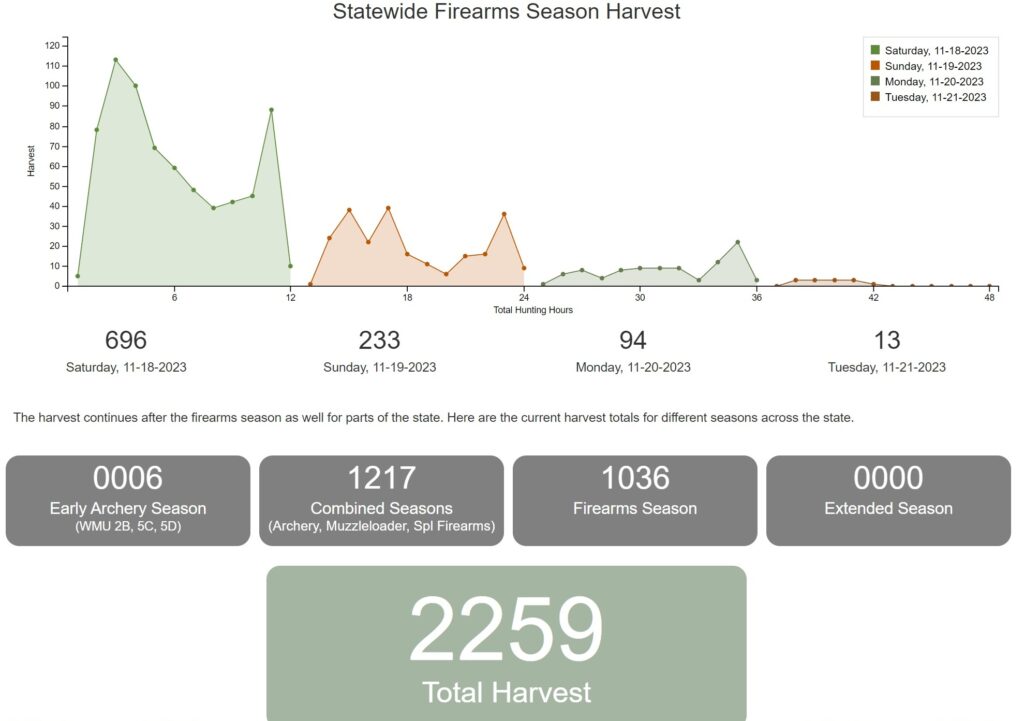
Harvest results as of the last night of regular rifle bear season, 2023. Not final, but not going to change much. The early season was the best season.
Reflections on 2020 bear season
As if by magic or just the batting of an eyelid, the much anticipated 2020 bear season is now behind us, having concluded at dark yesterday. Sad to see our friends go; we had such a fun time! The last of our bear hunting guests have left, cleanup has commenced, preparations are under way for Thanksgiving, and there are some reflections to be had on bear season.
First, where the hell were the bears? Serious question here. We hunt in a mountainous Northcentral area that is Pennsylvania’s “Bear Central.” And despite us daily scouring a lot of remote, very rugged territory that is usually home to lots of bears, we saw neither bears nor bear poop. None. It could be the warm weather has bears hunkered down under cool overhangs in even more remote places. It could be the low acorn crop has bears going in to hibernation early, because there is no more food for them to eat to put on the extra fat they need to hibernate successfully. The truth is, no bear tracks or poops have been seen around here for months, which is remarkable. I cannot think of any year prior like this.
Second, where were all the hunters? We heard only a few shots between Saturday and Sunday, and either none or one on Monday, and for sure none on Tuesday; and very few hunting parties were on the radio on any day. This means that few large scale hunting drives were going on. Without hunters moving across the landscape, the bears don’t have to move out of their way. They can just sit still and not run the risk of exposing their rib cage to a hunter’s bullet. That means that the bears can loaf about in some remote corner, escaping the unseasonable warmth or just waiting for the wafting human scent to drift away before making their usual rounds again. Which means the few hunters who are out don’t see much action.
Third, where were all the other critters, like turkeys and deer? Like with bears, we saw very little deer or turkey poop in the woods. And although I myself saw two whopper bucks and a five-point up close, no one else saw any deer. Nor did any of us see any turkeys. Once again, the absence of these otherwise ubiquitous animals could be due to the relative absence of acorns. Which would push the wildlife far afield to find food sources.
Fourth, despite all of our hunting setbacks, did any of us care a bit? No! We missed all of our friends who could not be with us for various reasons, like fear of the CCP virus, or family emergencies requiring them to stay at home. But those of us who gathered had a lot of fun nonetheless. And with or without a bear on the game pole, we would not have missed this time together for any reason at all. We caught up on our families, our work, our homes, cars, friendships, wives, and politics (yeah, there was a lot of pro-Trump politics). Some people drank way too much alcohol, and we got some great pictures of it all, like the one guy asleep on the cold ground outside. No, we don’t post those here. We ate like kings, that is for sure, and no one lacked for food or drink.
Finally, it is possible that the new early bears seasons (archery, muzzleloader, and special junior+ senior rifle) are removing so many bears from the woods that come rifle season, very few huntable bears remain to be had. According to real-time hunting harvest data posted at the PA Game Commission website, more bears were killed in the early seasons than in the official rifle season this year. This means there are fewer bears available for the rifle hunters. It is possible that many hunters expected this, based on last year’s harvest patterns, and they stayed home or hunted alone, instead of joining the big crew at camp, like usual. As of late today, just 3,138 bears had been killed total this year. That is about a thousand fewer than expected.
Based on this raw data alone, the early bear seasons are actually backfiring. They are not removing the high surplus number of bears that are beyond Pennsylvania’s social carrying capacity. Rather, the early bear seasons are removing the easiest bears and leaving few to be hunted in the later rifle season.
And this new dynamic could be the real story in PA’s bear season: There are so many early season bear hunting opportunities for individuals that they collectively take the wind out of the sails for the regular season hunters, thereby having a boomerang effect on the entire thing and limiting it.
We won’t know what all this data really means for another few years, and by then either great or even fatal damage will have been done to Pennsylvania’s traditional bear camp culture, with its big gatherings and big drives and big camp camaraderie dying out, or we will simply all have to learn to adapt to new ways of hunting. I have to say, there is no substitute for men gathering at a camp to hunt together. The gathered hunting party is the most human of experiences; it is an institution as old as our species. Its purpose was not just making meat, but also social and sociological.
I sure hope these myriad new early bear seasons are not self-defeating, in that they do not kill that traditional bear camp culture by removing its whole purpose ahead of the game. Question for the PGC: What incentive is there to push your body hard through rugged and remote landscapes, destroying your boots, tearing your clothing, and often losing or breaking some of your gear, including damaging your gun, when the animal you are seeking has already been removed?
Below are some photos from one of our trail cameras two years ago. Just days after bear season ended, a bear was caught gloriously and most joyously rubbing its back against a young white pine tree. Almost like a pole dancer. Pretty hot hip shakes there. We haven’t seen a bear anywhere around here since May this year.
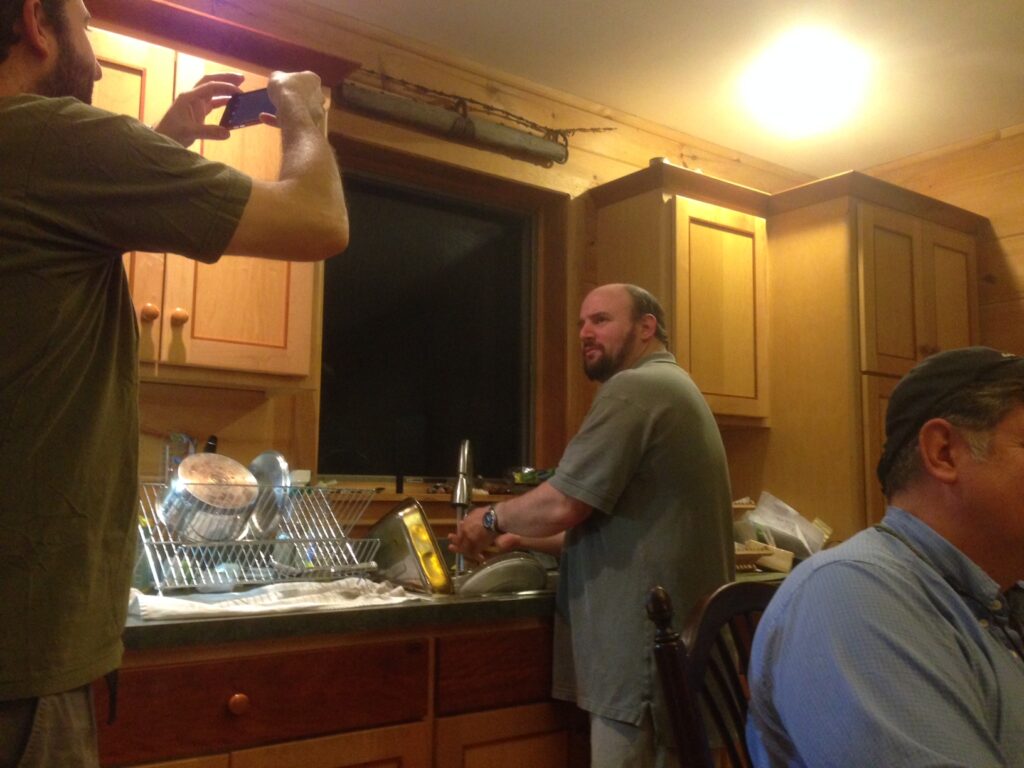
When one of our guys is finally browbeaten into washing dishes after years, it is cause for “Notify the media” acts like taking his unhappy picture. This is back in 2015. He still has to be browbeaten into washing the damned dishes
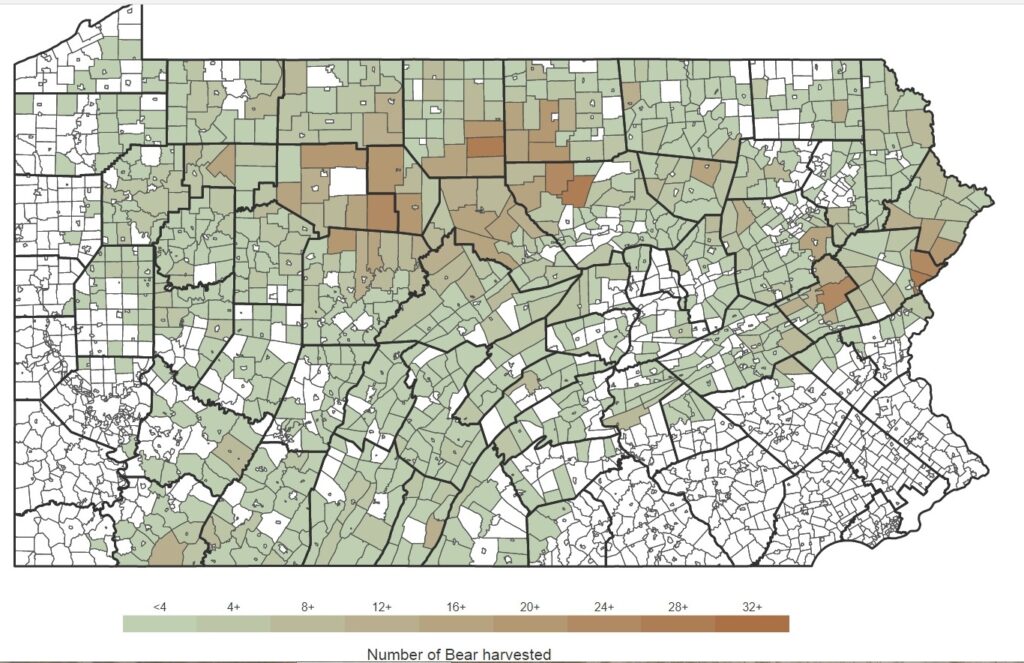
Lycoming County is the boot-looking shape in the northcentral area. Its northwestern corner is where we hunt. The darkest township there demonstrates the importance of organized hunting drives. A bunch of large hunting clubs are located in this area, and their members put on highly coordinated, obviously successful drives.
It will not hurt to drive slower, but it will definitely help
Are so many of us harried, in a hurry, a bit frayed around the nerves and feeling out of time?
Yes. This frenzied lifestyle is common. It is a sign and way of our time now, where life does not stand still for a second. Smart phones, GPS, email, texting, everything is happening real-time, right now, and we MUST respond and act. We are scheduled by the minute.
Adrenaline junkies like it, and everyone else stays laser focused to the exclusion of much else, goal oriented all the way.
This modern anxious existence is a form on tunnel vision, and it can be witnessed anywhere there is a red traffic light, a stop sign, a pedestrian cross walk, a parking lot, heck even a school pick up zone.
These locations are choke points, places where cars and people tend to gather, and where prevailing traffic must slow down. But a lot of drivers do not slow down in these areas, either because they have tunnel vision or because they are desensitized to congestion. Like everything else, they just plow through it.
Daggone, drivers are in a HURRY to get to that next stop sign, or the next red light. If they would pay attention to the vehicles around them, they’d see that blasting from one light to the next does not advance their cause, but it does eat up their gas and increase the risk of hitting someone.
Parking lots are the biggest buggaboo I see and experience, where drivers just go way too fast. Parking lots are relatively small areas and there is little room for error there. If a driver speeds, driving fast in a parking lot during business hours, there is a real possibility of a pedestrian or two walking through to their car but meeting up with the speedster, instead.
Let us ask some simple questions: Why are we hurrying in these small, tight, confined spaces? What actual time saved are we hoping to bank, a second, two seconds?
What is that miniscule amount of time worth against the life or health of another person, who may be walking nearby? What is our time savings worth when we hurt someone, and then suffer the consequences along with them?
It won’t hurt to slow down. It might even help, because accepting the terrible fate of losing a few seconds of time can become a form of Zen relaxation.
Try it, you will like it.
Downton Abbey’s “field sports” Part II
Guess I shot from the hip, shot first and asked questions later, didn’t identify my target too well, or another euphemism you may enjoy applying to the lack of foresight I brought to yesterday’s analysis of Downton Abbey’s field sports.
Yes, I could have sneaked a peak ahead of the coming scenes, like many other avid watchers of PBS’s hit show do, but because I lack the time and the inclination to sneak anything, I just sat down in my easy chair and watched the show unfold last night without advance knowledge of its content.
My Sunday afternoon essay about the mediocre depiction of the field sports of Downton Abbey was written beforehand.
So, yes, there was a shooting scene last night, or more accurately, some scenes of wing shooting at driven partridge from bona fide shooting butts, using authentic guns and nice clothes, woven in and out of the story about the Scottish castle party.
But once again, there was more focus on the clothes on the people holding the guns than on the Purdeys, Rigbys, and other Best-quality side-by-side shotguns being used to down the birds.
In 1924, $150,000-then-equivalent Purdey shotguns do not get left with the menial help in the kitchen. They are fussed and obsessed over by their owners, kept locked in their rooms, cased with abundant hand-made accoutrements, labeled beautifully by their makers, and often proudly handed down from generation to generation and worn with traditional hunting clothes.
Scottish castles are loaded with arms and armor, and we barely got a peak at the edged weapons welcoming guests through the front door.
The wagons taking the hunters to the field were right, and a nice touch. I have ridden in such wagons on traditional hunts, and they are today an unnecessary throwback. But back then, they were a necessity through muck and muddy moors.
Shooting driven partridge from the butts was mostly done right, with gun loaders ducking to avoid being seen by the birds, and we did see some people bunched up waving white flags, but a real drive could have been filmed for full authenticity. Actual dead birds could have fallen. Smoke could have emitted from the barrels. Etc etc.
Depicting the shooting sports in so briefly and so shallow a manner is the equivalent of dressing Lady Mary in a perfect 1920s top with modern hip-hugger blue jeans below. It is just wrong. Don’t do that!
A lot of non sequiturs occurred last night that really deprive the Downton Abbey audience of a full appreciation of the English field sport lifestyle, which actually reached its pinnacle in the 1920s (when cheap skilled labor was matched with newly superior steel and modern technology to create firearms that even today still command huge sums of money, not to mention the introduction and propagation of Asian pheasants to the English countryside), the time we are watching in the show.
I am sorry to criticize you, Julian Fellowes, because Downton Abbey is otherwise a great show, everything we want it to be.
Last night was disappointing, because the rich details of noble Scottish and English hunting rites should have been indulged. As a student of English history, you are missing a great, even important opportunity here to dig into a meaty subject which your audience will surely enjoy, even if it involves G-U-N-S.
Maybe in January 2016 we will get a more thorough treatment of a subject that may be missing from Mr. Fellowes’ life today, but which was a nearly daily ritual for the actual residents of Downton Abbey and their peers in the 1920s.
Are Turtles Crossing the Road Really a Threat?
Why drivers seem to target slow-moving, non-threatening little turtles is beyond understanding.
Don’t we all have a soft spot in our hearts for innocent, vulnerable, gentle creatures that do us no harm?
The same goes for snakes, which eat the rodent mice, rats, and chipmunks that do so much damage to our homes, crops, gardens, and vehicles.
Every spring and summer, turtles cross roads as they leave water bodies like rivers, ponds, lakes, and marshes, and seek out soft soil where they can lay their eggs, so that the next generation of their kind can continue their unimposing life cycle. Yet every year, roadways are littered with dead and wounded turtles, many dying slowly in the baking hot sun.
Their crime is nothing more than appearing in front of humans behind the wheel of a machine. Are so many of us really so homicidal or sadistic that we go out of our way to hurt, injure, and kill a little helpless animal?
The unfortunate, sad answer is Yes, a lot of drivers go out of their way to hit turtles with their cars. You can simply look at where the turtles lie, crushed or wounded on the side of the road, where the car driver had to actually veer off the roadway to hit the helpless little thing. What is really sad is that turtles take at least ten years to breed, so killing one or two (or stealing one or two) in a given area can doom or kill off the entire population there.
If you have compassion for turtles, you can watch these instructive videos below, where curious turtle-liking guys put a rubber turtle alongside some roads near their homes and generated some unhappy results, and where drivers get out to try and help injured turtles.
Bottom line is Yep, drivers went out of their way to run over the little rubber turtle.
